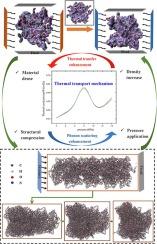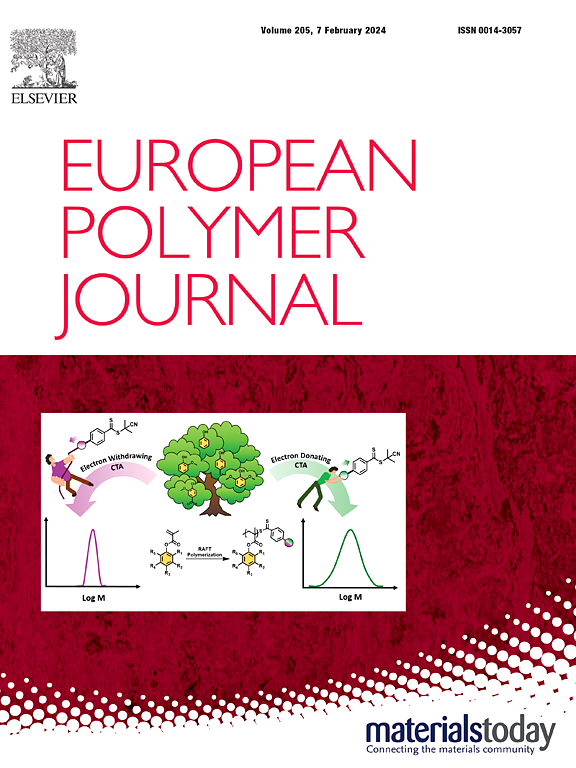Pressure-induced thermal conductivity optimization in polyimide materials for gravitational wave detection systems
IF 5.8
2区 化学
Q1 POLYMER SCIENCE
引用次数: 0
Abstract
Gravitational wave detection systems require high-stability precision equipment, making the control of thermal conductivity in applied materials essential for stable operation. Grounded in molecular dynamics theory, this study aims to enhance the thermal conductivity of polyimide (PI) materials through the application of external pressure. The Reverse Non-Equilibrium Molecular Dynamics (RNEMD) method was used to investigate the heat transfer mechanisms in PI structures under different compression pressures. The results show significant thermal conduction along polymer chains when the chain length exceeds 15 monomers. This observation aligns with the thermal conductivity mechanisms of actual molecular chain polymers, accurately reflecting the structural behavior of PI. Furthermore, when continuous pressure was applied between 0 and 12 GPa, complex patterns of thermal conductivity emerged. Initially, thermal conductivity exhibited an upward trend, followed by a decrease, and finally a rise with increasing pressure, resulting in at least a 40 % increase in thermal conductivity. The dynamic changes in thermal conductivity are attributed to complex variations in molecular interactions and heat conduction pathways. Moderate compression enhances effective phonon transport between molecules, whereas excessive compression induces structural disorder, thereby reducing thermal conductivity. The study also examined the impact of model density and structural changes on thermal conductivity during compression. With the same structure, thermal conductivity exhibited a gradual increase with rising density. However, within the density range of 1.6 to 1.9 g/cm3, thermal conductivity showed a significant increase. At consistent density, thermal conductivity abruptly decreased at lower compression levels. With increased compression, thermal conductivity changes gradually leveled off. This comprehensive study delved into the interactions between chain length, pressure, and structural factors affecting the thermal conductivity of PI materials. These findings provide an important theoretical foundation for the development and design of new materials, potentially optimizing the thermal management performance of gravitational wave detection systems.

引力波探测系统中聚酰亚胺材料的压力诱导热导率优化
引力波探测系统需要高稳定性的精密设备,因此控制应用材料的导热性对稳定运行至关重要。本研究以分子动力学理论为基础,旨在通过施加外部压力来提高聚酰亚胺(PI)材料的热导率。研究采用反向非平衡分子动力学(RNEMD)方法研究了不同压缩压力下聚酰亚胺结构的传热机制。结果表明,当聚合物链长度超过 15 个单体时,沿聚合物链的热传导非常明显。这一观察结果与实际分子链聚合物的导热机制一致,准确地反映了 PI 的结构行为。此外,当在 0 到 12 GPa 之间持续施加压力时,导热性出现了复杂的模式。最初,热导率呈上升趋势,随后下降,最后随着压力的增加而上升,热导率至少增加了 40%。热导率的动态变化归因于分子相互作用和热传导途径的复杂变化。适度压缩会增强分子间的有效声子传输,而过度压缩则会导致结构紊乱,从而降低导热率。研究还考察了压缩过程中模型密度和结构变化对热导率的影响。在结构相同的情况下,热导率随着密度的增加而逐渐增加。然而,在 1.6 至 1.9 g/cm3 的密度范围内,热导率出现了显著增加。在密度一致的情况下,热导率在压缩水平较低时突然下降。随着压缩量的增加,热导率的变化逐渐趋于平稳。这项综合研究深入探讨了影响 PI 材料热导率的链长、压力和结构因素之间的相互作用。这些发现为新材料的开发和设计提供了重要的理论基础,有可能优化引力波探测系统的热管理性能。
本文章由计算机程序翻译,如有差异,请以英文原文为准。
求助全文
约1分钟内获得全文
求助全文
来源期刊

European Polymer Journal
化学-高分子科学
CiteScore
9.90
自引率
10.00%
发文量
691
审稿时长
23 days
期刊介绍:
European Polymer Journal is dedicated to publishing work on fundamental and applied polymer chemistry and macromolecular materials. The journal covers all aspects of polymer synthesis, including polymerization mechanisms and chemical functional transformations, with a focus on novel polymers and the relationships between molecular structure and polymer properties. In addition, we welcome submissions on bio-based or renewable polymers, stimuli-responsive systems and polymer bio-hybrids. European Polymer Journal also publishes research on the biomedical application of polymers, including drug delivery and regenerative medicine. The main scope is covered but not limited to the following core research areas:
Polymer synthesis and functionalization
• Novel synthetic routes for polymerization, functional modification, controlled/living polymerization and precision polymers.
Stimuli-responsive polymers
• Including shape memory and self-healing polymers.
Supramolecular polymers and self-assembly
• Molecular recognition and higher order polymer structures.
Renewable and sustainable polymers
• Bio-based, biodegradable and anti-microbial polymers and polymeric bio-nanocomposites.
Polymers at interfaces and surfaces
• Chemistry and engineering of surfaces with biological relevance, including patterning, antifouling polymers and polymers for membrane applications.
Biomedical applications and nanomedicine
• Polymers for regenerative medicine, drug delivery molecular release and gene therapy
The scope of European Polymer Journal no longer includes Polymer Physics.
 求助内容:
求助内容: 应助结果提醒方式:
应助结果提醒方式:


